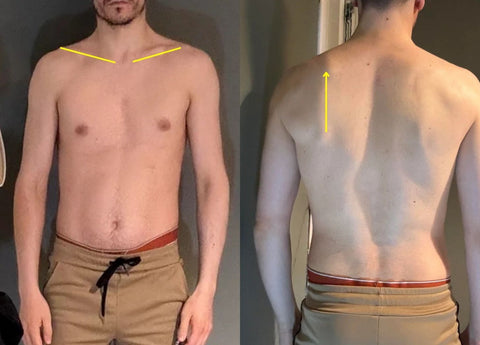Table of Contents
Ever looked in the mirror and noticed one shoulder sitting higher than the other? It's more common than you think, and it's not just about appearance. Uneven shoulders can throw off your balance, affect breathing, and create long-term tension patterns you may not even notice until pain sets in.

If you're wondering how to fix uneven shoulders, the first step is understanding what caused them. This kind of imbalance usually forms slowly over time due to habits that load one side of the body more than the other.
Do you:
- Carry your bag over the same shoulder every day?
- Sleep on the same side every night?
- Always reach or twist in one direction at work or while using a computer?
- Play a one-sided sport or instrument?
These repetitive patterns can shift your shoulder girdle into misalignment. Sometimes the issue is visible as scapular elevation, where one shoulder blade rides higher on the ribcage than it should. Other times, the shoulder may be depressed, dropping lower than normal due to weak support.
Over time, your nervous system accepts this new position as your "normal." And once that happens, even your brain begins reinforcing the imbalance. That's why simply stretching or strengthening is not enough to fully correct one shoulder sitting higher than the other.
This blog offers a complete strategy to reverse the problem from the root. You will learn:
- How to test if you have a high or low shoulder
- What causes lopsided shoulders and postural asymmetry
- How to fix unbalanced shoulders through specific drills
- Targeted scapular elevation corrections
- The truth about what really creates long-lasting shoulder balance
If you're tired of seeing one side sag or spike in photos, or if your shirts always fall off one shoulder, this is your starting point.
How to Know If One Shoulder Is Higher Than the Other
Step 1: Check Your Collarbones
Stand tall in front of a mirror. Keep your arms relaxed. Find your collarbones with your fingers and trace the line across. Now look closely is one side sitting higher than the other? Even a slight difference can point to a deeper imbalance your body has learned to live with.

Step 2: Uneven Upper Trapezius: Quick Self-Test
Stand naturally in front of a mirror. Keep your shoulders relaxed. Feel along the top of each shoulder to find the ridge of your upper trapezius muscle. Look closely: is one side higher, bulkier, or more raised?

Step 3: Uneven Shoulder Blades: Visual Check
Have someone take a clear photo of your back while you stand relaxed with arms at your sides. Look at the shape and position of your shoulder blades (scapulae). Notice if one is sitting higher, lower, or sticking out more than the other. This difference can signal muscle imbalances or compensations.

Step 4: Test For a Forward-Shifted Shoulder
Have someone photograph you from above, looking down at your shoulders while you stand relaxed. Now look closely: is one shoulder more forward than the other? Significant differences may even be visible by simply glancing down at your own shoulders.

Step 5: Observe Your Clothes
Does one sleeve always slide down? Does your bra strap keep slipping off the same shoulder? That's not random—that's your wardrobe telling you one shoulder is lower than the other.
How to Fix Uneven Shoulders by Rewiring the Root Cause

Step 1: Break the Habit Loop That Broke Your Posture
Sleeping on the same side, carrying a bag on one shoulder, twisting in one direction while working or scrolling — these repeated habits silently shape your posture. Before you stretch or strengthen anything, become aware of the patterns that created the imbalance in the first place.
Step 2: Train the Eyes to Recenter the Shoulders
Your eye movements control more than just vision. They influence head positioning and directly affect how your shoulder blades sit on the ribcage. When your visual reflexes are off, your head subtly rotates or tilts, pulling your shoulders out of alignment. Eye drills are one of the fastest ways to restore shoulder symmetry.
For specific tongue posture techniques that support overall postural alignment, explore our comprehensive guide on oral posture's impact on shoulder positioning.
Step 3: Rebuild the Connection Between Your Brain and Shoulder Blades
Most shoulder rehab skips the step that matters most: motor control. Your brain needs to clearly communicate with the muscles around your scapula. If that connection is weak or disrupted, your shoulders will move unevenly no matter how much you strengthen them. Scapular control drills should come before loading.
Step 4: Realign the Spine to Stop Feeding the Imbalance
If your spine is laterally tilted or rotated, your shoulder positioning will automatically compensate. Realigning the spine shifts the foundation underneath the shoulder girdle. Without this correction, everything else you do will have a short shelf life.
Step 5: Stimulate the Cerebellum for Better Coordination
The cerebellum is the part of your brain that controls posture, coordination, and timing. If it is underperforming, you lose the ability to control your shoulders with precision. The right inputs — especially through the eyes, vestibular system, and midline training — can strengthen this control fast.
Understanding the jaw and neck connection is crucial here, as jaw tension directly influences cerebellar function and shoulder positioning through fascial chains.
Step 6: Strengthen After You Rewire
Once your nervous system is firing correctly, you can begin strengthening. But it needs to be intelligent loading. Focus on scapular depression or elevation depending on your asymmetry, and train in positions that match the way you actually use your body throughout the day.
Step 7: Reevaluate the Real Source of the Problem
Uneven shoulders are rarely just a local shoulder issue. Collapsed arches in the feet can twist the entire kinetic chain. A misaligned jaw can subtly rotate the skull and shift one shoulder forward. You need to address the inputs from below and above, not just the shoulder muscles themselves.
Many people find that SI joint dysfunction contributes to shoulder imbalances through compensatory patterns up the kinetic chain.
Step 8: If One Shoulder Moves Forward, Check the Jaw
Forward shoulder posture on one side is often linked to jaw imbalance or a history of dental work. When your bite is off, it can torque the skull and pull your shoulder girdle with it. This shows up especially in people who have had wisdom teeth removed or clench on one side more than the other.
Fixing uneven shoulders isn't about chasing perfect symmetry—it's about restoring functional alignment so your body moves and feels as it was meant to.
When to Expect Results
Most people notice results almost immediately because the right neurological input instantly recalibrates how the brain organizes posture, focus, and movement. When the visual and postural systems send clear, accurate signals, the nervous system responds in real time. You feel it in your posture, your mood, and even how grounded you are.
Timeline for shoulder correction:
- Week 1-2: Improved awareness and initial postural shifts
- Week 3-4: Noticeable shoulder alignment improvements
- Month 2-3: Stable, lasting changes in shoulder positioning
That's the power of targeting the root neurological cause, not just the symptom. However, consistency is key - daily practice of the brain-body reconnection drills yields the fastest results.
Combine with Posture Correction
You cannot fully correct posture without aligning both the visual and plantar systems. That's why real, lasting change starts by recalibrating the eyes and restoring foot function. Address one without the other, and the compensation patterns return.
This is exactly why the Fix My Posture Bundle exists to recalibrate spatial mapping and anchor the body's foundation. The results are immediate, and the changes are long term.
Advanced Training Options
For those interested in more sophisticated correction methods, our NeuroVision course offers eye movement techniques that rewire brain-posture control for lasting shoulder alignment.
We'll show you the drills no one else is teaching. We'll address what everyone else overlooks. And you'll finally stop chasing symptoms.
Looking for additional resources? Check out our related guides:
- Is Your SI Joint Jammed Again? Discover Long-Term Relief!
- Jaw and Neck Connection: The Intrinsic Relationship You Need to Know
- Proper Tongue Posture Benefits: Complete Guide
Frequently Asked Questions
Conclusion
Uneven shoulders aren't just a cosmetic concern—they're a window into deeper neurological imbalances that affect your entire body. The traditional approach of stretching tight muscles and strengthening weak ones misses the fundamental truth: your brain controls your posture.
By addressing the root neurological causes through eye training, cerebellar stimulation, and proper motor control patterns, you can achieve lasting shoulder alignment that goes far beyond temporary fixes. The 8-step brain-based strategy outlined in this guide provides a comprehensive roadmap to not just fix uneven shoulders, but to restore optimal function to your entire postural system.
Remember, fixing uneven shoulders isn't about chasing perfect symmetry—it's about restoring functional alignment so your body moves and feels as it was designed to. When you address the neurological root causes, the physical changes follow naturally and permanently.
Start implementing these strategies today, and experience the immediate difference that comes from working with your nervous system instead of against it. Your shoulders—and your entire body—will thank you.
References:
Day, B. L., Steiger, M. J., Thompson, P. D., & Marsden, C. D. (1993, September). Effect of vision and stance width on human body motion when standing: Implications for afferent control of lateral sway. Retrieved from https://www.ncbi.nlm.nih.gov/pmc/articles/PMC1143881/
Kavounoudias, A., Roll, R., & Roll, J. P. (2001, May 01). Foot sole and ankle muscle inputs contribute jointly to human erect posture regulation. Retrieved from https://www.ncbi.nlm.nih.gov/pmc/articles/PMC2278585/
Oyarzo, C. A., Villagrán, C. R., Silvestre, R. E., Carpintero, P., & Berral, F. J. (2014). Postural control and low back pain in elite athletes comparison of static balance in elite athletes with and without low back pain. Retrieved from https://www.ncbi.nlm.nih.gov/pubmed/23963269
Shaikh, A. G., & Zee, D. S. (2017, December 19). Eye Movement Research in the Twenty-First Century-a Window to the Brain, Mind, and More. Retrieved from https://link.springer.com/article/10.1007/s12311-017-0910-5
Wang, Z., & Newell, K. M. (2012, September 19). Asymmetry of foot position and weight distribution channels the inter-leg coordination dynamics of standing. Retrieved from https://link.springer.com/article/10.1007/s00221-012-3212-7
Nejati P, Safarcherati A, Karimi F. Effectiveness of Exercise Therapy and Manipulation on Sacroiliac Joint Dysfunction: A Randomized Controlled Trial. Pain Physician. 2019;22(1):53-61.
Tamer S, Oz M, Ulger O. Effects of sacroiliac joint mobilization on hamstring muscle flexibility and quadriceps muscle strength. Orthop J Sports Med. 2014 Nov; 2(3 Suppl). doi:10.1177/2325967114S00174




